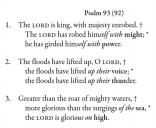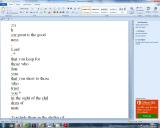Request for help (tedious...)
-
The most time-consuming part of the SEP accompaniments is typing out the verses. Copy/paste from the original yields strange results in Sibelius. SVR has been patiently trying to help out, but even copying from the InDesign file is not working. If I type them all out manually, a nice result is possible (see the most recent postings), but that task itself will add 300% to the process of finishing this.
My thought is to take screenshots from the PDF, and then paste them over blank space in the organ notation. This is also time consuming, but less so than typing everything out (and dealing with the bold/italic texts).
Would anybody be willing to go through the SEP file and create screenshots of the verses? (if they are split between pages, two screenshots for the verses to any given proper). Something like the attached file.
And of course, if a few people are willing to split the work up, it makes it that much easier.
Much gratitude to any who would be willing to assist in this.
 sample.jpg511 x 420 - 67K
sample.jpg511 x 420 - 67K -
One thing I can do easily is split the PDF into individual page images. Would that help?
Thanked by 1ryand -
Much easier to split the work up that way!
-
Nobody? :(
-
As someone who will definitely purchase a book of this project when it is complete, I will volunteer to help.Thanked by 1ryand
-
Actually, working from the source PDF can be better: you can copy and paste the text from there, not just a formatted image.
That would give you the results of typing, but more expediently.
-
Chonak,
Pasting it into Sibelius that way creates a single line of text (no line breaks) in a tiny font with no bold or italics. Changing the text properties of the file doesn't help, as the pasted text ignores whatever settings are applied to the file ... so the process of touching up takes as long as just typing it out (hence the reason I was doing them manually for awhile).
I wonder if this might be circumnavigated getting MS Word involved. I will toy with it this evening. -
[revising my comment:]
Can you use Sibelius for the scores and a word processor for the text portions, and then use a desktop-publishing program to combine the pieces? That would be a quality-oriented way to handle this, giving you control over how the text is presented.
If you were starting from scratch, I'd recommend Lilypond, since its "book" facility lets you pull in non-Lilypond materials pretty easily.
-
Yeah, that's essentially what I was going for. The (incomplete) book is all in one big Sibelius file, which I can export as a PDF once the music is all inputted. Then I want to add the text underneath the verses, similar to what's been posted in the past. Your idea will provide a cleaner / more "in-control" result, rather than dragging image files around.
-
Well, you could just make the Sibelius file as a big PDF without the verses, but leaving space for them. Then afterward you can bring the PDF into a desktop-publishing program (I use open-source Scribus), and add in all the blocks of text, and apply styles to them in the DTP program. And, sure, that part is a manual job; but once you've defined the text styles, it's just repetitive. And I think you can use "master pages" to fix the position of the text block on the page and save some work.
-
I am not sure how reliable I'd be, but I'm happy to help typeset or format anything you need. I have a license for Adobe InDesign.
-
How To Enter Text Into Sibelius
1. Copy text.
2. Paste into a plaintext app to remove all formatting.
3. If text is not hyphenated, go to: http://juiciobrennan.com/hyphenator/ (It will do it instantly. I think it works for Latin too.)
4. Copy the text out of hyphenator.
5. Paste into a plaintext app (keep all text in a page in case you mess it up in Sib)
6. Go to the first note of the text insertion point in Sib, and get the 'lyric' entry cursor to appear.
7. Using the paste command, the text will enter into Sib a syllable per note. If you have a melisma, simply tap the space bar to create a hyphenated melisma.
This is the fastest way to put text lyrics into Sib.Thanked by 1CHGiffen -
Thanks francis. That's a useful trick.
On this project, I'm only inserting text per-note on the antiphons, and those go quickly. It's the big blocks of verse text that are time-consuming. -
If I understand aright, the tricky part for you is that you'd like to preserve the text formatting from the SEP book - isn't that the catch?
-
Yes. What francis described is for use with lyric text directly beneath the notes, like with the antiphons. The verses are those multi-line blocks.
-
Here's what I get if I copy from the PDF into MS Word.
o_O
 Untitled.jpg1280 x 1024 - 206K
Untitled.jpg1280 x 1024 - 206K -
Right. I think you can't really eliminate the work of formatting the text. But you don't have to be the person who does it. If people want to get the book, they can provide either volunteers (supervised by someone with an eye for consistency and quality control), or crowd-funding to hire a desktop-publishing pro. I'd recommend Mary Weaver, who takes jobs like this; she did the DTP work for "Parish Book of Psalms", and she has made the annual Colloquium music book for several years running.
-
Good idea. I bet you could kickstart enough money for something like that, considering how wide of a reach SEP has.
-
Here is a rough example of pasting the image into blank space. This would go very quickly with all the images already cropped and organized.
(Ignore that the notation is blurred)
 BodyBloodVerse.pdf69K
BodyBloodVerse.pdf69K -
I don't see any text in that image
-
fixed
-
What about something like this? I used to do SEP with unaccompanied antiphons, and verses in four-voice harmony. I used a screen-grabbing app and stuck images into Word. This is what I assembled for my choir:

 SEP 32Ord.pdf1M
SEP 32Ord.pdf1M -
I like that, chonak. How did you capture the text?
The only concern with that is that longer verses might not fit on one page. The format I'm working with is an antiphon on the left page and its corresponding verses on the right (no page turns for the organist). Is it possible, in some instances, to create two columns for the verse text, but keep it at the same size? Psalm number centered, with two columns underneath.
Also, is the double-spacing necessary? I like it visually, but again there is the concern for space. It might work better to single-space only the longer verses, but I would like to keep the layout as consistent as possible. -
I think the spacing's adjustable. I should set another example, to get an idea of how long it takes. In this one, I was making up templates for the process, so doing the first case takes much longer than the second case.
-
Thanks a lot for toying with this. Looking forward to any "discoveries" of yours.
-
Here's one for All Saints (Low Key). It took me 20 minutes to produce. Some of that went into engraving the psalm tone, and those can be reused.
The line-spacing of verses is reduced here.
I prepared the psalm text by copying it from Adam's PDF on-line and adding in markup for the formatting.
 book.pdf26K
book.pdf26K -
I have all of the psalm tones written out, so adding the text is all that is needed. Using your process, how quickly do you think these could be knocked out with a team of 3-4?
-
About 35 minutes.
Well, not really.
Here's a psalm with its introit:
[updated to include high key]

 introit.pdf555K
introit.pdf555K -
Oh, I really like that output. Looks very professional.
-
chonak, check yo' msg's
-
PDF's of three examples (Corpus Christi, Sept. 23, Requiem Mass) have been posted. I realize that such a small sampling does not provide enough info about the entire work in order to make an informed judgment. However, one thing puzzles me deeply: in none of the examples given does the accompaniment end with a chord in its root position.
I'm wondering if the accompaniments for even Adam Bartlett's psalm tones have been scrutinized by others. Perhaps the way I accompany chant and compose accompaniments for it is not au courant. Are there authorities who recommend that cadences, especially final cadences, not end with chords in root position?
Later addition: I looked at the PDF's once again. And I see that CGM posted the one for Sept. 23. That harmonization does end with a chord in root position. Sorry about that, CGM. -
None of these examples end in root position. Thank you for noticing. It's intentional. You're observing the verses in isolation, while in practice these accompaniments will lead to the next line of of the verse or back to the antiphon. These are never the final cadence, and are written to be harmonically "open-ended" so that a sense of forward motion, and not finality, is achieved. Hearing these examples, one expects something else to follow. That is the intended effect, as it just so happens that there is indeed more to come!
http://forum.musicasacra.com/forum/discussion/7825/sep-accompaniment-book/p1
You might more accurately pass judgement having reviewed some of these. -
@ryand: Yes, I had seen several of the SEP accompaniments on other threads.
Certainly the final final cadence is at the end of a setting. But even a lowly psalm tone has a flex, a mediant cadence, and a final cadence.
I only made my observation because the accompaniments with which I am most familiar (Bragers, Desrocquettes, Potiron, Marier) seldom depart from ending both antiphon and psalm tone accompaniments with a chord in root position.
Perhaps you'll start a new trend. -
Perhaps.
I'm just perceiving the Psalm tones as part of a larger unit - each proper being its antiphon and verses, and these parts operating together rather than existing individually. If these tones were being set for individual recitation, say in singing the Divine Office, then I'd approach them differently.Thanked by 1Adam Wood -
I've noticed root-position chords at the end of some Marier tones too, but felt, perhaps naively, that it was a weakness, inasmuch as it gave a sense of finality where it wasn't appropriate; so I'm sympathetic to Ryan's option.
-
I also like psalm tones to have that unfinished sound, urging to move on to the antiphon. So that's three of us.
Welcome to the MusicaSacra Forum!
To participate in the discussions on Catholic church music, sign in or register as a forum member, The forum is a project of the Church Music Association of America.
Categories
- All Discussions21,127
- General Music Discussion8,224
- Job Openings199
- Management of Music Programs850
- Choral Matters533
- Church Documents and Rubrics524
- CMAA Notes302
- Events716
- For Newcomers: Read First26
- Sacred Polyphony547
- Hymnody872
- Gregorian Chant: General2,699
- ↳ Graduale Romanum and Liber Usualis368
- ↳ Graduale Simplex60
- ↳ Semiology63
- Vernacular Plainsong696
- Anglican Use and Anglican Chant68
- Organ, Other Instruments and Repertoire435
- New Composition/Works in Progress1,293
- Recordings234
- Music for Hispanic Ministry159
- Music Education: Children211
- Music Education: General222
- News Items245
- Positions Wanted2
- General Discussion: Catholicism739
- Amusements177
- General Discussion1,035
- Opinions119





